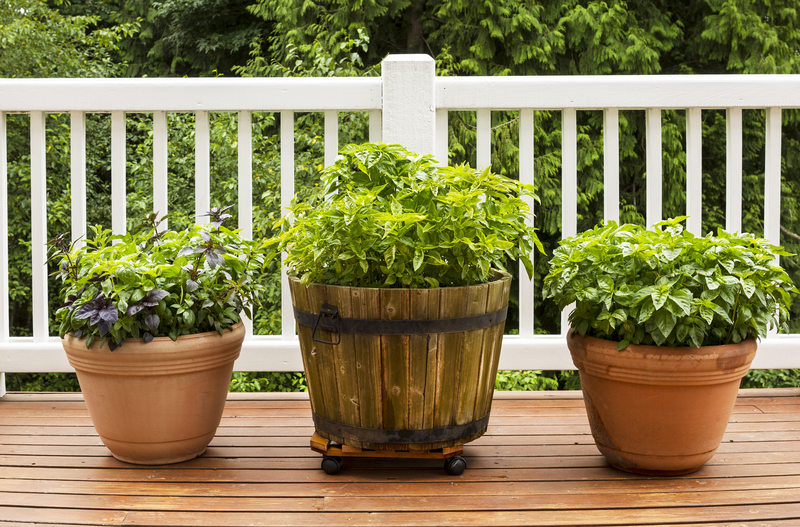Outsmart Bad Weather with These Garden Tips
Posted on 24/05/2025
Outsmart Bad Weather with These Garden Tips
Gardening is a relaxing and rewarding hobby, but unpredictable weather can pose significant challenges even for seasoned green thumbs. From unexpected frosts and heatwaves to torrential rains and strong winds, nature often puts your gardening skills to the test. However, with the right strategies, you can protect your plants and ensure your garden thrives, no matter what the weather brings. In this comprehensive guide, we'll share the best ways to outsmart bad weather and keep your garden flourishing year-round.

Why Is Weather so Crucial for Gardening?
Weather affects every aspect of gardening, from soil moisture and temperature to sunlight availability. Extreme weather events can quickly undo months of hard work, so understanding how weather impacts your garden is crucial. By anticipating possible issues and preparing accordingly, you can outsmart inclement weather and enjoy healthy, productive plants.
Common Types of Bad Weather and Their Effects on Gardens
- Heavy Rain: Can lead to root rot, waterlogged soil, and nutrient leaching.
- Drought: Causes plant stress, wilting, and stunted growth.
- Heatwaves: Results in dehydration and sun scorch.
- Frost and Freezes: Damage or kill tender plants and disrupt growth cycles.
- Strong Winds: Break branches, uproot plants, and dry out soil rapidly.
- Hail: Shreds leaves, bruises fruit, and damages plant tissues.
How to Outsmart Bad Weather in Your Garden
With a little creativity and careful planning, you can protect your garden from bad weather and maintain its health and beauty. Here are expert-backed tips and actionable strategies to help your garden weather any storm.
1. Plan Your Garden Layout for Maximum Protection
- Analyze Wind Patterns: Plant windbreaks such as hedges, fences, or sturdy shrubs on the side of prevailing winds.
- Design Raised Beds: Helps with drainage in areas prone to heavy rainfall and flooding.
- Position Sensitive Plants Safely: Place delicate plants closer to sheltering walls or in protected corners.
- Group Plants by Water Needs: Reduces over- or under-watering during droughts or storms.
*By taking these preliminary steps, you give your plants the best chance to thrive despite erratic weather.*
2. Choose Weather-Resilient Plants
Selecting the right plants is one of the smartest moves a gardener can make to outwit challenging weather. Native plants or those adapted to your local climate will always perform better during weather extremes.
- Perennials: These plants have extensive root systems and are often more resilient than annuals.
- Drought-tolerant species: Succulents, lavender, sedums, and ornamental grasses thrive even during dry spells.
- Wind-resistant shrubs: Ornamental grasses, junipers, and willow-leaved shrubs bend rather than break in strong winds.
- Frost-hardy varieties: Kale, cabbage, pansies, and primroses withstand cold snaps.
Pro Tip: Always check USDA hardiness zones or your local climatic data before planting. This simple step prevents future disappointments!
3. Build Effective Protective Structures
Physical barriers can shield your garden from almost any kind of harsh weather. Consider adding these to your gardening arsenal:
- Row Covers and Cloches: Lightweight fabrics or glass domes keep plants warm and shielded from wind and pests.
- Cold Frames and Greenhouses: Provide a controlled environment for sensitive plants during frosts or heatwaves.
- Shade Cloth: Prevents sun scorch and excessive heat on the hottest days.
- Windbreaks: Hedges, solid fences, or screens reduce wind speeds and protect against soil desiccation.
*Investing in these structures is a sure way to outmaneuver unpredictable weather and enjoy a longer growing season.*
4. Mulching: Your Garden's First Line of Defense
Mulch is an indispensable tool in weather-proof gardening. It moderates soil temperature, retains moisture, and protects plant roots from both extreme cold and heat.
- Organic Mulch: Straw, bark chips, or compost feed the soil as they decompose.
- Inorganic Mulch: Gravel or pebbles prevent erosion and are ideal for high-rainfall areas.
Pro Tip: Apply a 2-4 inch thick layer of mulch around your plants, keeping it slightly away from the stems for optimal protection.
5. Smart Watering Techniques for Every Weather
Whether you're battling flooding rains or drought, effective watering habits are essential to outsmart bad weather in your garden:
- Drip Irrigation: Delivers water directly to the roots, conserving water during dry periods and avoiding wet foliage that encourages disease.
- Water Deeply and Infrequently: Encourages roots to grow deep into the soil, making them more resilient in dry spells.
- Morning Watering: Reduces evaporation and prevents fungal diseases by allowing leaves to dry before nightfall.
- Rain Barrels: Collect rainwater for sustainable irrigation during droughts.
*Adapting your watering methods to the current weather conditions will ensure healthier, more resilient plants.*
6. Soil Management: Prepare for the Worst
Healthy soil is better equipped to withstand extremes of weather. Here's how you can make your soil more resilient:
- Add Organic Matter: Compost and manure improve soil structure and water-holding capacity.
- Test and Amend Soil: Regularly check pH and adjust with lime or sulfur as needed.
- Avoid Compaction: Wet weather can compact soil, so avoid walking on garden beds.
- Improve Drainage: Use sand or raised beds to help excess water flow away from plant roots.
Remember: Good soil isn't just fertile--it's also your first defense against harsh weather impacts.
7. Regular Maintenance & Vigilance
Keeping an eye on your garden and performing regular upkeep can be the difference between survival and disaster during severe weather:
- Check Weather Forecasts: Be proactive about severe weather by following local updates and acting early.
- Prune Wisely: Remove weak or dead branches that can break off during storms and damage other plants.
- Support Tall Plants: Use stakes or cages to prevent wind damage.
- Inspect and Repair Structures: Ensure greenhouses, fences, and covers are secure before a storm.
- Clear Debris: Remove fallen leaves and other debris that can harbor pests or cause blockages during rainstorms.
Consistent maintenance is key to minimizing weather-related losses in your garden.
Weather-Specific Gardening Tips
How to Outsmart Heavy Rain
- Improve Drainage: Ensure your soil drains quickly by mixing in sand or creating raised beds.
- Install French Drains: Help divert excess water away from vulnerable areas.
- Choose Flood-Resilient Plants: Mint, sedges, and some irises tolerate wet soils.
Keep an eye on young plants, which are especially susceptible to root rot during excessive rainfall.
Dealing with Drought
- Mulch Generously: Prevents water evaporation and cools plant roots.
- Group Plants by Need: Plant species with similar watering needs together for efficient irrigation.
- Water at Dawn: Maximizes uptake and minimizes loss to evaporation.
Protecting Plants from Frost and Freeze
- Cover Plants: Use cloches, old sheets, or frost fabric to protect tender species on cold nights.
- Water Before a Freeze: Moist soil retains heat better than dry soil, providing slight warmth to roots.
- Choose Frost-Resistant Varieties: Opt for plants known to survive your area's expected low temperatures.
Guarding Against Heatwaves
- Provide Afternoon Shade: Use cloth or plant taller companions to shield delicate species from the hottest sun.
- Increase Watering: Monitor soil moisture closely and adjust as needed.
- Choose Heat-Loving Plants: Tomatoes, peppers, and beans are more tolerant of summer extremes.
Reducing Wind Damage
- Plant Natural Windbreaks: Rows of trees, bamboo, or shrubs lessen wind speeds.
- Stake Vulnerable Plants: Tall, leggy plants often need extra support during storms.
- Use Netting or Protective Screens: Prevent leaves and flowers from tearing or breaking.
Gardening Innovations for Bad Weather
Modern technology and products can make outsmarting poor weather even easier:
- Self-Watering Systems: Ensure consistent moisture during absence or drought.
- Weather-Tracking Apps: Stay ahead of troubling forecasts and adapt your plans instantly.
- Soil Moisture Sensors: Provide real-time alerts to prevent over- or under-watering.
- Water-Retaining Crystals: Mixed into soil to improve drought resilience for sensitive plants.
Embracing these innovations can simplify your gardening routine and make your plants even tougher against bad weather.

Summary: Outsmart Bad Weather, Grow a Resilient Garden
With a blend of smart planning, plant selection, structural support, and consistent maintenance, you can outsmart bad weather in your garden and enjoy healthy, productive plants all year long. Weather-proof gardening isn't about fighting nature--it's about working with it and preparing for its surprises.
- Understand your local climate and possible threats.
- Choose resilient plants and build in protective structures.
- Practice proactive watering and soil management techniques.
- Stay alert, maintain your garden, and use technology to your advantage.
Don't let unpredictable weather ruin your hard work! Apply these garden tips to safeguard your green sanctuary, and you'll discover that every weather challenge can be outwitted, leading to a thriving, beautiful garden no matter what the forecast brings.
Frequently Asked Questions - Outsmarting Bad Weather in Your Garden
What are the best plants for a weather-resistant garden?
Native plants and climate-adapted perennials are the most reliable. Consider lavender, sedum, ornamental grasses, and frost-proof vegetables for multi-weather resilience.
How can I protect my garden during a severe thunderstorm?
Secure loose objects, cover sensitive plants, and close greenhouses or cold frames. After the storm, inspect for damage and support battered plants promptly.
Is it possible to start a garden in an area with extreme weather?
Absolutely! With careful plant selection, effective structures, mulching, and regular maintenance, you can create a productive garden even in the toughest climates.
Need more gardening advice? Stay tuned for more expert tips to outsmart bad weather in your garden and turn every setback into a setup for growth!

